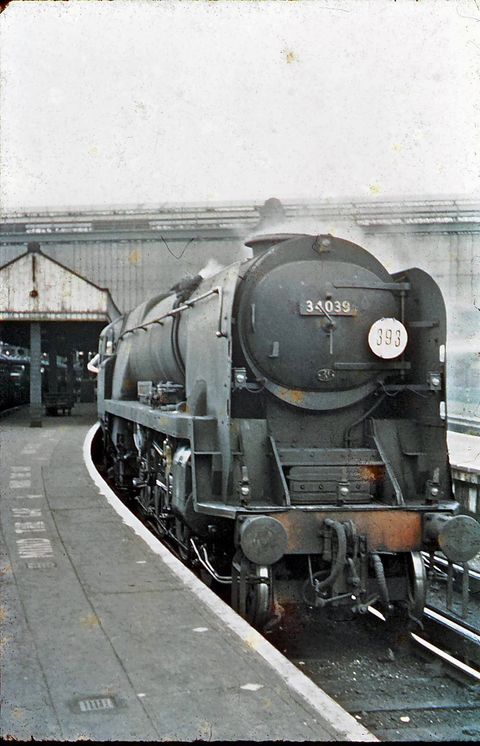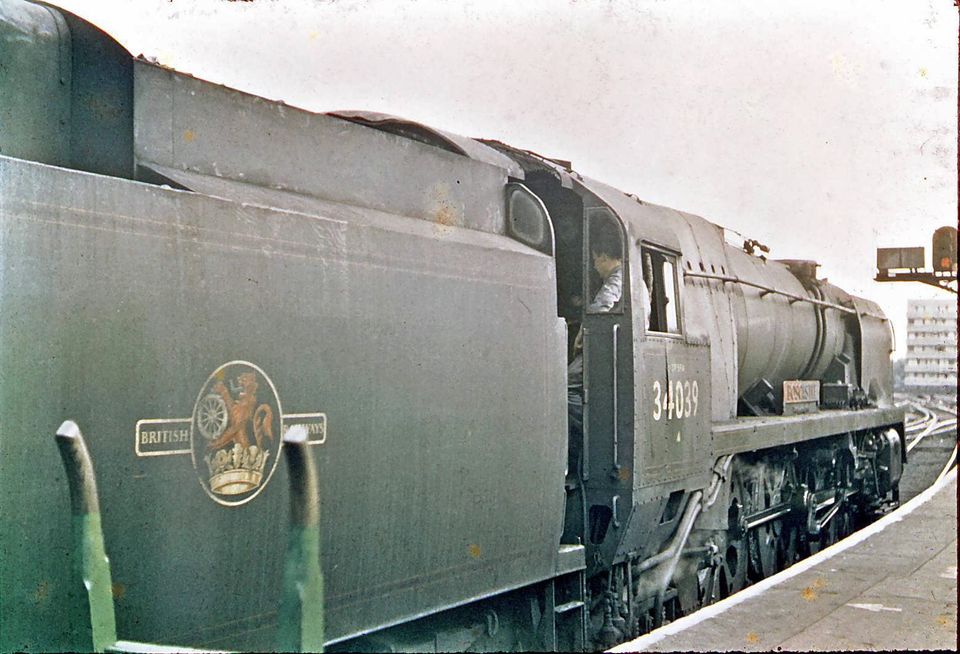Reminiscences of David Hall, a former BR fireman
In the summer of 1963, David Hall was on the footplate of Boscastle, preparing to depart with a Waterloo-Basingstoke train. He asked a photographer on the platform (whose name cannot now be recalled) to take a couple of photographs of the locomotive.
These are David’s recollections of the day, and of the West Country class in general.
The West Country class locomotive.
“It is a good looking engine, that I felt proud to work on and was always pleased when being allocated one for the day’s duties. There was nothing to dislike about them, they were quick to pick up speed and fast, even with a full load.”
“They steamed well and were easy to fire, you only had to keep the back corners and inside the door full, then with just a tap of the shovel on the shoe in the fire box mouth and shoot the coal up the front of the fire box. Firing was an easy action just standing in the middle of the footplate, push the shovel into the tender with the left arm then twist around and shoot the coal into the fire. No need to walk around the foot plate with a shovel full of coal.”
“The fact they had a covered cab made any tender first work more comfortable, but they could get hot in the summer months.”
“Their best feature as far as the fireman was concerned was the drop grate, as all fireman on the Southern region had to clean their own fire box of clinker, this was a job that had to be done at the end of the day’s run. I say Southern region because the Great Western region had shed staff to do this work. All the depots I worked on had some shared runs with Great Western engines, so it was always a bone of contention that we had to clean the clinker out of the fire boxes.”
The day of the photo.
“In the top link at Basingstoke, two of our shifts were semi fast commuter trains to Waterloo and back, one early morning the other early evening return to Basingstoke. We normally had a West Country class locomotive for these runs.”
“For the afternoon shift we came on duty about midday to find out which engine we had been allocated, that day it was 34039 Boscastle. I don't know if it was on loan at Basingstoke shed or an overnight lodger on its way to its home depot.”
“Then we start to prepare the engine, hoping that not too many tools have been taken off the engine by other firemen earlier in the day. The prep. takes about one hour and entails spreading the fire over the fire box and gradually building it up. Then trimming the coal in the tender, checking the fire irons, shovel brush and pick. Then the toolboxes for oil cans, spanners, lamps flags and detonators.”
“Then go around outside to make sure smoke box door is tight, sand boxes full and connecting links, vacuum and steam pipes are in good order. Clean the cab and steam wash the footplate, hoping it dries before the driver gets back and is ready to leave. Fill the tender with water and collect the carriages from the sidings.”
“Then we are ready to depart with five stops to Woking then fast to Waterloo. On approaching Waterloo, you had to run the fire down and reduce the water in the boiler, so as to make sure the engine did not blow off from the safety valves, while standing under the glass roof. “
“We had to wait for about fifteen minutes while our carriages formed the next train out. It was then tender first to Nine Elms depot, where we prepared the engine for the return run and had our snack.”
“We leave Nine Elms tender first, about twenty minutes before we are due to leave Waterloo with the return journey. On arrival at Waterloo, I would have had to couple up the coaches while avoiding being electrocuted by the third rail. Then gradually liven up the fire ready to depart.”
This is time when the photos were taken.
“Then it was fast to Woking and five stops to Basingstoke. On arrival at Basingstoke shunt the coaches to the sidings, then on to the engine sheds and put the engine to bed. This entails cleaning out the fire of clinker, raking the remainder of the fire back under the door, then emptying the smoke box. This usually took about one hour but with the help of the drop grate you could do it in about thirty minutes and so go home early.”
My career on the railways
April 1954. A week after leaving school I started work as an engine cleaner at Weymouth MPD.
April 1955. After my 16th birthday I became a passed cleaner, which meant I could do fireman's duties when required.
August 1955 . I transferred to Andover junction MPD as a Fireman.
September 1959. I transferred to Basingstoke MPD working as a fireman in the top links.
September 1963. I left the railways.
"I had a happy time working on the railways and only left because of all the changes that were starting to happen. Also, I was married with a young family and wanted a more secure future."
David Hall, March 2021
A note from James Tawse. “If I remember rightly, Basingstoke shed (70D) closed as a running shed in either 1963 or 1964, and thereafter was only used for coaling and watering - the locos. for the London trains being provided by Eastleigh, where
Boscastle was shedded.”
Copyright of the images on this page.
If you know who took these photographs, then please get in touch - we'd be delighted to hear from you.

